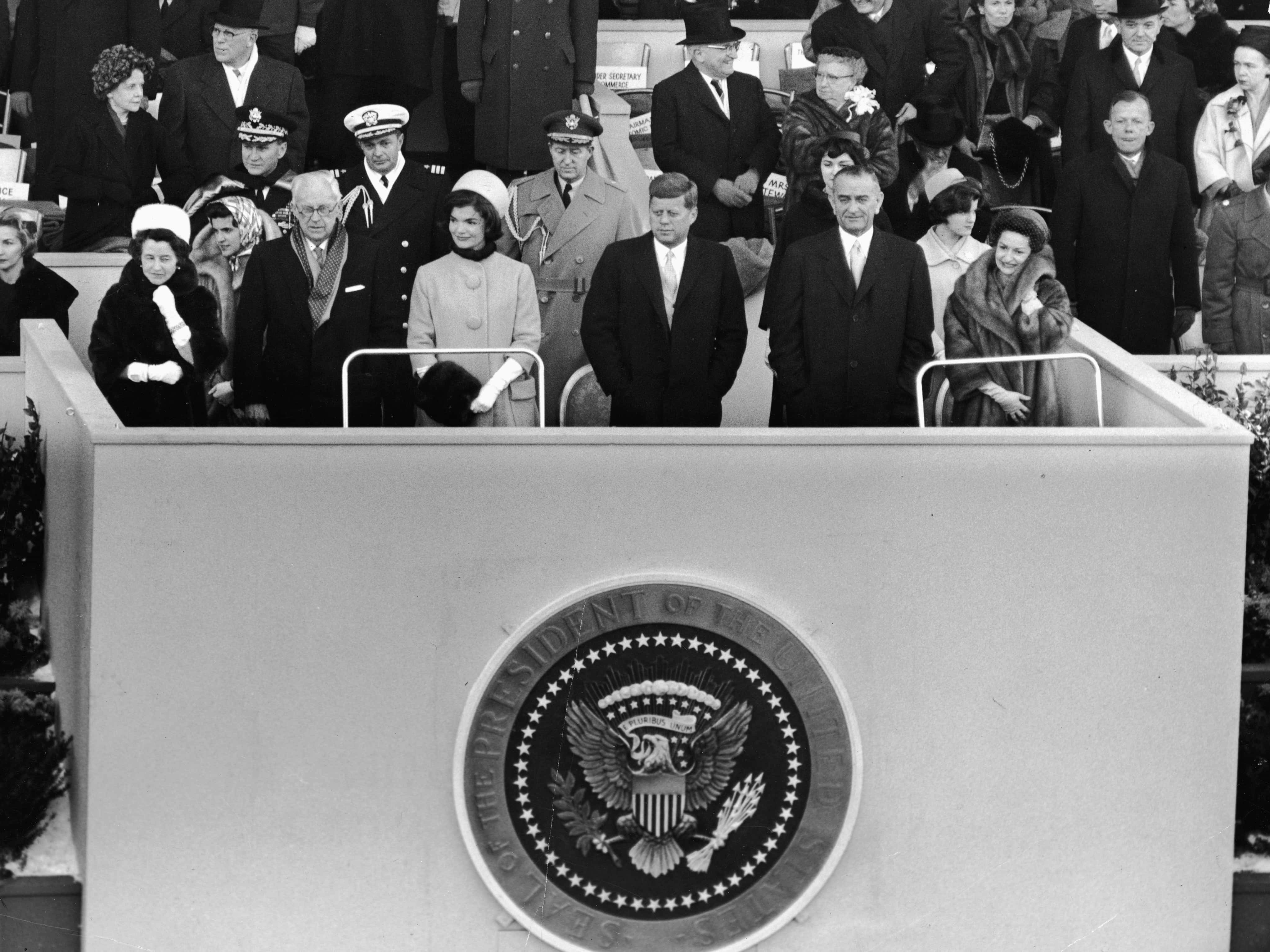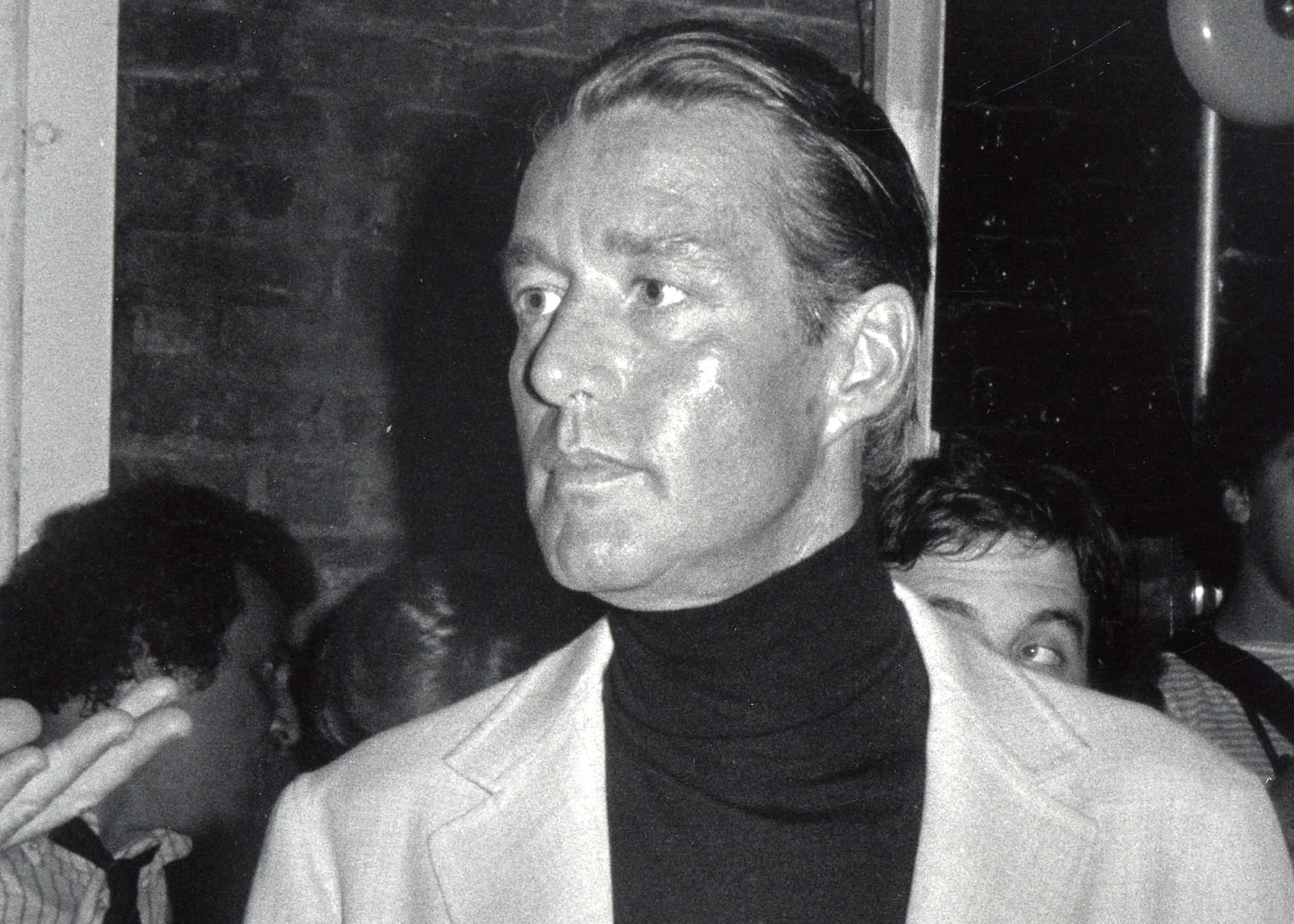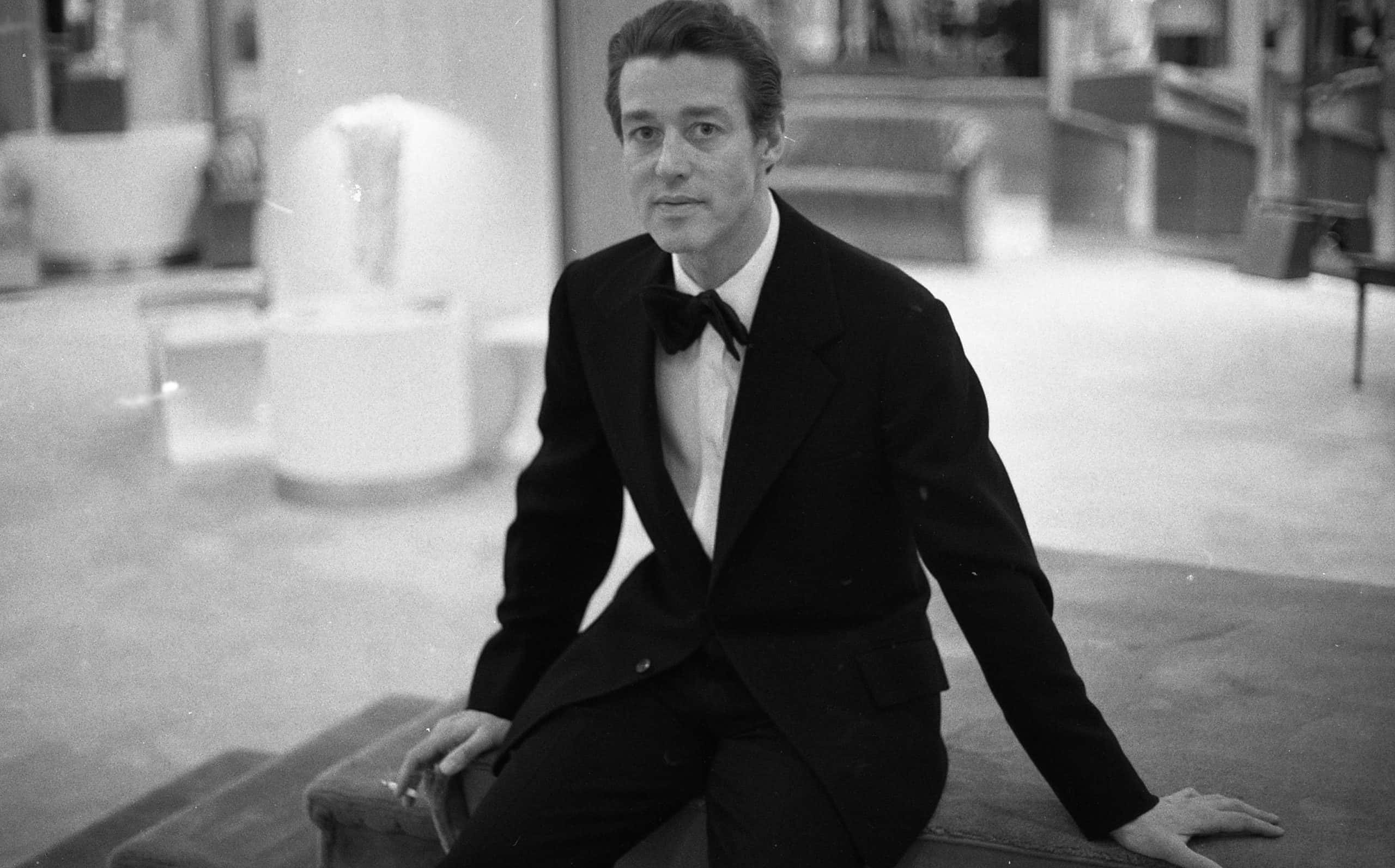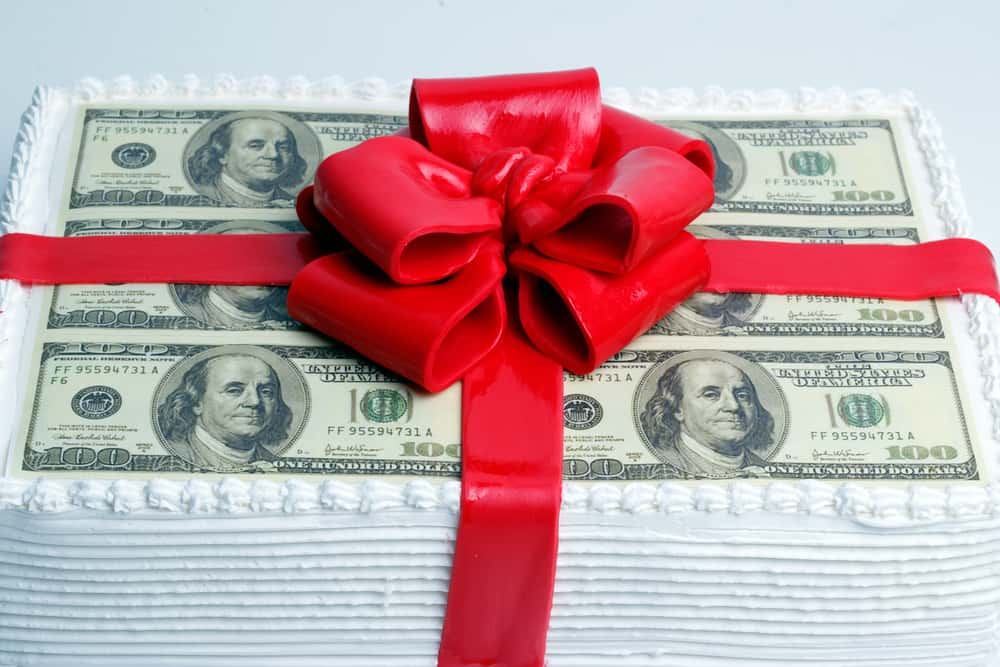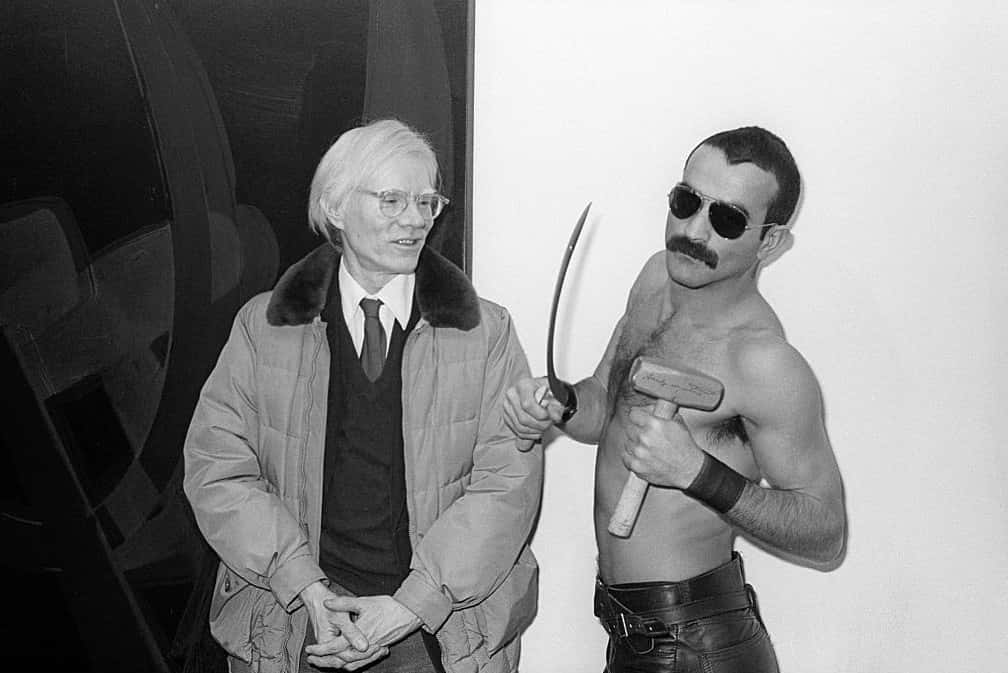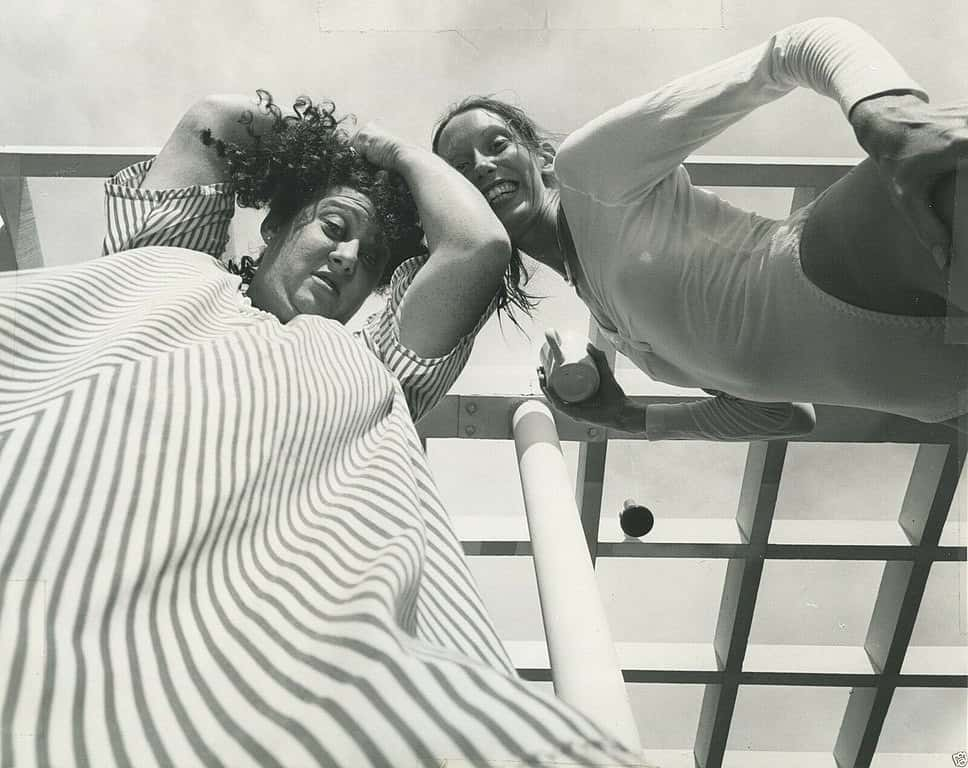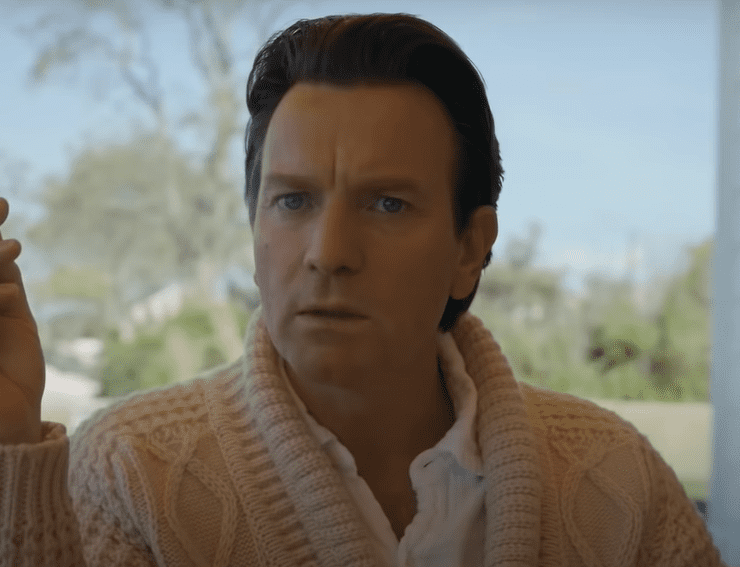Halston’s ascent from dust bowl innocent to Studio 54 hedonist is filled with everything one loves in a rags to riches story: celebrity friends, chaotic parties, blackmailing lovers, and even a president’s wife wearing a particular hat. Mostly, though, there is fashion. Fashion and a remarkable and gifted artist who worked as passionately as he played.
1. His Parents Were Rather Ordinary
Roy Halston Frowick was born in Iowa in 1932. His father was an accountant and his mother was a stay-at-home mom. So where did Halston get his love of fashion? It was his grandmother. Well, at least she taught him how to sew. Soon Halston was making and altering clothes for his mother and sister. His next stop would be the one that sent him to the top.

2. He Took Chicago
When Halston was 20 years old, he dusted the dirt off his shoes and moved to Chicago. He spent his nights in classes at the School of the Art Institute of Chicago and during the day, he worked as a window dresser. Within a year of arriving in Chicago, Halston was ready to break out on his own—and luckily, he had a head for fashion.
3. He Started At The Top
By that, I mean he started with hats. In 1953, Halston—just 21 years old—launched his own hat business. Somehow, these hat designs caught the eyes of a few A-list Hollywood celebrities. Kim Novak, Gloria Swanson, Deborah Kerr, and Hedda Hopper all wanted to get their top covered by Halston. With clients like these, it was time for a shop and a brand.
4. He Branded His Name
As a child, Roy Halston Frowick used his middle name to avoid confusion with his uncle Roy. So when it came to branding his hats, the name Halston seemed like a good choice. But he wasn’t happy with the sound of his name. It turns out that Halston’s family pronounced the "Hal" in Halston like it was the computer in a 2001: A Space Odyssey.
So Halston changed "Hal" sounds into a "Hall" sound: a simple way to evoke a much grander sense of style. Did it work? You be the judge…
5. He Approached The Mothership
In 1957, Halston moved to New York City and started working for hat maker Lilly Daché, whose hats still appear at the New York Metropolitan Museum today. After his time working in Daché’s nine-storey 56th Avenue office, Halston approached the mothership of NYC fashion: department store Bergdorf Goodman, where he quickly became head milliner. But he soon had his eyes on a bigger prize.
6. He Turned Heads Away From The President
As Halston’s star was rising, JFK was running for office. It may seem like politics and fashion don’t mix—but it ended up changing Halston’s life overnight. When JFK won, the new First Lady, Jackie O, turned up at the inauguration wearing one of Halston’s pillbox hats. People took note. It was a huge boost to Halston’s creations and his burgeoning celebrity.
Halston was set. What could possibly go wrong? Um…did someone forget to mention that fashion is fickle?
7. His Cash Cow Dried Up
Who could have predicted that hats would fall out of fashion? Well, it’s only in retrospect that it seems totally obvious. Clearly, Halston needed a plan B or he’d be out of the game. It was simple—all he had to do was look down. There was the entire rest of the body to adorn with beauty. But who was going to pay for it?
8. He Needed To Pivot
Switching from hats to a full line of women’s made-to-measure apparel took courage and tenacity. Luckily, Halston had both. There was just one problem. What he didn’t have was money. Sure, his hats had made him a fair amount of cash, but he needed a studio, he needed models, and he needed a whole bunch of other stuff that costs money.
In short. he needed a benefactor.
9. He Struck Oil
Halston’s benefactor came in the form of Texan millionaire Estelle Marsh, whose family was rich from oil, gas, cattle, and land. Marsh single-handedly financed Halston’s move from hats to a full line for women. She also helped him open his first boutique on Madison Avenue. Have the words "you go girl!" ever been more appropriate?
10. He Gave Himself A Makeover
Halston was joining the A-list, but there was something he was trying to keep hidden from them. He always tried to distance himself from his humble Iowan roots. After all, nothing is less glamorous than growing up in the Depression-era Midwest. Halston wanted to look like a designer, but he wasn’t sure what that look entailed.
I think he must’ve looked up "pretentious" in the dictionary to get this signature style: slicked hair, black turtleneck, sunglasses, and a long white holder for his cigs. Voila! Halston had his iconic look. And…it worked!
11. He Was A Star Magnet
Halston had his new look and what he needed next was to surround himself with the right people. Lucky for him, his boutique attracted the big celebrities of the day, including Greta Garbo, Lauren Bacall, Elizabeth Taylor, and Bianca Jagger. While these icons were certainly a little extra, it was actually the lack of extras that brought them to Halston.
12. He Detested The Unnecessary
Halston’s approach to fashion was to keep it simple, which caused critics to call him a minimalist. But really, he just had a strong pet peeve for things on clothes that failed to achieve their purpose. On his hit list were: inoperable bows, buttons that didn’t hold, and zippers that, for whatever reason, failed to zip. He wasn’t purposefully minimalist, he just hated extras that weren’t necessary. Halston had some very strong opinions about fashion, and he wasn’t afraid to express them…
13. He Panted About Pants
Halston was very passionate about the things he created and one thing he loved to talk about was women’s pants. He loved the freedom they gave women. Halston said that before pants, women had trouble with low furniture and even getting into low cars. Does this make him a feminist? Well, as long as a woman had the money, they could experience the freedom of Halston…but that was about to change.
14. He Became Ready To Wear
Until 1969, you had to be pretty close to the upper-upper crust to buy a Halston—it was all made-to-measure, after all. But once the decade turned to the disco era, Halston started to sell his creations as ready-to-wear. It was a new and fabulous decade, and Halston wanted more women to enjoy his revolution in fashion. The disco 70s would also see the start of one of Halston’s longest and most intimate friendships.
15. He Was A Friend Of Dorothy’s...Daughter
It was love at first sight for Judy Garland’s daughter Liza Minnelli. Not with Halston himself, but with a sweater and pants set she saw at Bloomingdale's. Once she saw the clothes, she wanted to meet the man behind them, so her godmother arranged a rendez-vous. Halston and Minnelli became instant BFFs. But there was much more than friendship up for grabs for these two.
16. He Styled A Career
As a singer, dancer, actor, and showbiz personality, Liza Minnelli put her life and career into Halston’s experienced hands. He dressed her for parties and, most notably, designed her yellow frock for when she nabbed the Oscar for Cabaret in 1973. He even convinced her to get that cute signature haircut that just screams Liza. But he did more than style the star—he made her.
17. He Had A Front Row Seat
Minnelli didn’t just get style advice from Halston—she trusted him with her career. Every show that Minnelli performed, Halston got a sneak preview in a very exclusive venue: his own living room. Minnelli wanted Halston’s feedback on every aspect of her shows before she put them on for the public. Of course, it wasn’t just work for these two—There were also the parties.
18. He Made A Special Dessert
Minnelli was a regular at Halston house parties—and they quickly spun out of control. As he became more famous, his parties got more elaborate. If it was a dinner party the special item on Halston’s menu was a baked potato, with caviar and sour cream. But dessert was something different. It didn’t require a spoon or fork—or even a plate, for that matter.
According to Vogue fixture Andre Leon Talley, it all went right up guest’s noses…if you catch our drift.
19. He Threw Parties At The Studio
Halston also hosted many parties at the legendary Studio 54. For Elizabeth Taylor’s birthday he made a cake decorated to look like her—wearing a Halston, of course. 46 barely-dressed Radio City Rockettes performed—one for each year of her life. But that was nothing compared to what he did for Mick Jagger’s wife Bianca.
When she turned 32, he had her enter on a white horse led by a man wearing nothing but body paint. However, sometimes his Studio 54 antics ended in disaster.
20. He Released Doves
Halston liked spectacle and he also seemed to like animals. One idea he had was to release snow-white doves—by the dozens—into Studio 54. Unfortunately, the spectacle ended in a gruesome tragedy. The lights frazzled the birds. The result was a horrifying sight: burnt feathers slowly descending on the partiers below. But there were other, even more outrageous extravaganzas happening at Halston’s home.
21. He Staged Outlandish Shows
Halston’s Moroccan-themed soirees at his home consisted of lusty shows with hired performers—and they might have been his most scandalous parties. The performers weren’t wearing Halston—or any other clothes, for that matter. In front of the guests, they did things usually meant only for the bedroom. In one case, there was even an animal on stage. It was wild, carnal, and intensely private. Except for that odd-looking man with a camera…
22. There Are Pictures
Pop artist and New York celebrity Andy Warhol was a regular at these parties. Funny, I’d always pictured him as sort of a wallflower. Maybe that’s a bit true, as Warhol brought a camera to these events and freely clicked away. These days, taking pictures at a party like this would end up as a TMZ nightmare. But Warhol had some discretion—well, at least until he wrote in his diary.
23. He Burned Through Money
Andy Warhol once told a story of a rather, ahem, unique birthday cake Halston had made. It wasn’t just decorated with icing—it had actual paper money included in the design. Ewww. I can only hope it was appropriately cleaned beforehand. Not to worry, as Halston’s idea was to burn the money with the candles. Warhol, ever the frugal artist, convinced Halston instead to give away some cash with every slice of cake. It’s no wonder Warhol stuck close to the designer…
24. He Was A Way In
Legendary nightclub Studio 54 could only be legendary for you if you could actually get past the closely monitored doors. Bouncers stood outside to see to it that only the fabulous got to enter—no riff-raff. Andy Warhol had one rule for a sure-fire entry into Studio 54. He said: go in with Halston—or, at the very least, go in wearing him. Luxurious living, for sure—but it can’t last forever, can it?
25. He Spent Money Like It Was Going Out Of Style
At this point, Halston’s line had earned close to $30 million. And what does a nice boy from Iowa do when he finds himself suddenly extremely rich? Well, he loved getting take-out from the best restaurants. And if he was out of town? No bother. He just had the food delivered by private jet. You think this was a bad decision? Well, there are plenty more.
26. He Made Life Destroying Decisions
In the early 70s, Halston made two utterly disastrous decisions that would have repercussions for his entire life. One was selling his business to Norton Simon Inc. for $16 million. The other was more personal: He started a relationship with makeup artist Victor Hugo. We’ll soon see why both of these choices would come back to bite him in the butt.
27. His Boyfriend Was An Embarrassment
There were two things that Victor Hugo did that Halston really didn’t like. One was showing up at Studio 54 wearing only a jockstrap—hey, maybe it was laundry day! The other was anytime he arrived anywhere in public wearing a Halston dress. Hugo reportedly did both of these things with annoying regularity. Nice boyfriend.
But the real reason for Hugo’s transgressions shows some fairly twisted frenemy behavior.
28. He Had A Frenemy
It really seemed like Halston and Hugo’s relationship was toxic—but there was a disturbing reason for that. It turns out that someone was paying Hugo to do the very things that infuriated Halston. Worse still was the person who paid him: It was Halston’s supposed "best bud," Andy Warhol. Warhol was jealous of Halston’s success and really enjoyed watching him squirm in embarrassment.
Rather than have a fight with Warhol, Halston decided he had more important dragons to slay.
29. He Went To Battle For America
It was a fashion battle of international proportions: the best American designers versus the best in France. The runway would be in the Palace of Versailles and it would be epic. Halston appeared alongside US designers Anne Klein and Oscar de la Renta in an effort to raise money for the restoration of the palace—and to put American designers on the map.
But Halston’s terrible temper almost brought the whole event to its knees.
30. He Had An Epic Meltdown
While preparing for the event at Versailles, Halston had a disagreement with a choreographer. The disagreement turned into an argument that led to a very Halston meltdown. And what solution did Halston’s come up with? Nothing less than canceling the entire event. Yikes. Luckily, Liza Minnelli was on hand to calm the temperamental designer down. And what was the result of all this?
31. He Slayed On The Runway
When Halston’s models had finished on the runway, audience members acted in a bizarre way. They ended up throwing their programs in the air. In Minnelli’s words, they "went bananas" for Halston’s work. The Women’s Wear Daily headline of November 30, 1973, read: "Americans came, they sewed, they conquered". But something else happened at Versailles. Something—gasp—even more important than beautiful clothes.
32. He Broke the Color Barrier
In addition to owning the runway at Versailles, Halston did something else for fashion—he emphasized inclusion. Halston and other American designers who had been invited to Versailles hired 10 Black models for the runway. This was a legendary boost for more diversity in the fashion industry—which, until then, mostly featured white models. Clearly, white wasn’t his favorite color.
33. He Said No To White
I guess in the early 70s, wearing white for a wedding was feeling a little passé. Halston went against tradition and designed a dark jade velvet wedding gown for his collection. The bride was Mary Wells Lawrence, but what made this connection important for Halston’s career was the groom. He was none other than the CEO of Braniff International Airways. And what do airlines need? You guessed it: uniforms.
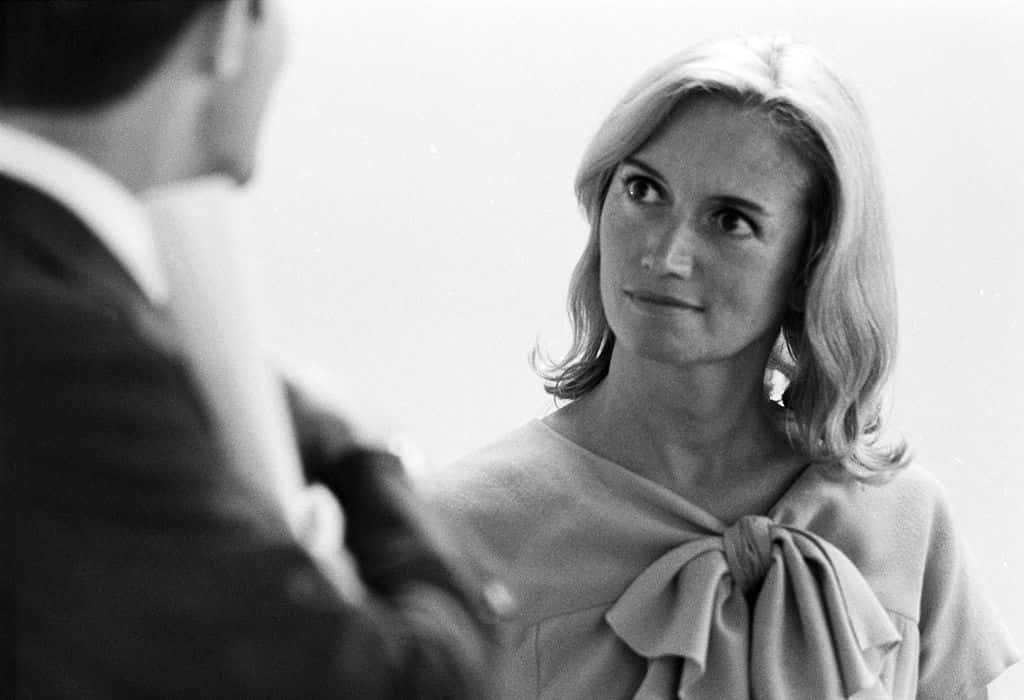 [/media-credit] Mary Wells LawrenceGetty Images Mary Wells Lawrence
[/media-credit] Mary Wells LawrenceGetty Images Mary Wells Lawrence
34. He Flew The Fashionable Skies
It took ten years, but in 1976, Halston finally got the job designing hostess, pilot, ticket agent, and ground personnel uniforms for Braniff International Airways. A designer doing uniforms was out of this world, and created a huge buzz for both the airline and for Halston. After this, if you wanted a Halston uniform for your company, you had to get in line. And that wasn’t all he did…
35. He Outfitted Everyone
Halston’s uniforms for Braniff International Airways were such a hit, it wasn’t long before others wanted the Halston touch added to their workplaces. And Halston didn’t seem particularly picky about who he designed for. He did everyone from the Girls Scouts to the US Olympic Team. From Avis Rent A Car to the NYPD. But he didn’t stop at uniforms.
36. He Revived The Caftan
Once Halston had conquered uniforms, there was nothing stopping him. He quickly moved into menswear, luggage, handbags, bedding, and lingerie. Vogue even credited him for inventing the caftan—even though they date back to the 17th century. Halston made one for Jackie Kennedy and soon, Elizabeth Taylor was sporting them.
But before long, Halston was sniffing around for more ways to make money.
37. He Fought For His Friend
Halston also expanded into fragrance—and he turned to one of his muses for the iconic glass vial. Elsa Peretti designed a beautiful bottle that looked like a slightly leaning water drop. However, his team’s reaction was catastrophic. According to them, the bottle had to be rectangular. But Halston went head to head against them in favor of his friend’s design.
38. He Made A Payment In Fur
Halston wanted to pay Peretti handsomely for her beautiful bottle design. After negotiations, they agreed that Halston would pay Elsa Peretti for her design with, among other things, a fur coat. The payment thrilled Peretti and she said it was a symbol of her friendship with Halston. But what happened to that coat wouldn’t thrill anyone except PETA.
39. His Had A Fiery Friendship
Halston and Peretti got into a terrible argument—a friendship-ending argument. Peretti needed to show Halston how angry she was and she wanted to make it very theatrical. Halston watched in horror as Peretti did the unthinkable. She flung the beautiful—and outrageously expensive—fur coat into a fireplace. Their friendship quite literally went up in flames.
40. He Had An Entourage
Like Peretti, the people Halston worked with often became famous in their own right. His regular troupe of models became known as Halstonettes. But they were more than just models—he called the Halstonettes his muses. He went to parties with them and they even traveled together. Clever Halston then went a step further and turned the Halstonettes into advertising.
41. He Created A Human Billboard
Halston wasn’t much up for typical marketing. Instead, he treated the Halsonettes like a living billboard. He would enter parties and nightclubs surrounded by them. Because the Halstonettes wore head-to-toe Halston, it created an organic advertisement. But, if you looked closely, there was something unusual about these Halstonettes.
42. He Moved Diversity Forward
Before Halston, most major designers showed little to no diversity in their models. What Halston showed in Versailles was just a start. Halston continued to include models of diverse backgrounds and color. These included Pat Cleveland, Beverly Johnson, and a young Iman. There was also Pat Ast, who was a plus-sized model. All this led to a plus-sized paycheck—which he was about to need.
43. He Was Brave But Naive
Halston’s on-again-off-again lover Victor Hugo was looking for money—so he decided to betray the man he’d once loved. He thought he could sell some of his wild tales about Halston to, among other publications, the New York Post. When Hugo tried to blackmail Halston with the stories, Halston took a brave stance. He refused to pay him anything. Brave yes, but maybe stupid as well.
44. He Paid A High Price For Privacy
Halston soon had second thoughts about saying no to Hugo’s blackmailing. Stories of the substance misuse and orgiastic parties surely wouldn’t go over well with some of his more conservative clients. Eventually, Halston caved. He gave Hugo paintings by Warhol, expensive objects, and some cash in exchange for Hugo’s signature on a nondisclosure agreement. But that wasn’t the end.
45. He Sold It All For A (JC) Penney
There are few things as anti-couture as a deal with a middle-of-the-road American department store. And, at the time, nothing said middle America more than J.C. Penney. In 1983, Halston signed a deal with the retail chain worth one billion dollars. They called the line Halston III and it made his clothes available for pretty much every American woman.
And that, it turned out, was a big problem.
46. He Went Cheap
Because of Halston’s deal with J.C. Penney, many of his high-end retailers had a new view of his brand: They thought it had been cheapened. And a cheapened brand didn’t appeal to their high-end customers. The first to go was Bergdorf Goodman, the store that had been with him at the beginning. But there were worse things about to happen to Halston and his brand.
47. He Got Passed Around
Back in 1973, when Halston sold his brand to Norton Simon Inc., it seemed like a great way for Halston to keep designing and not worry about money. But ten years later, Norton Simon Inc. let Halston go to Esmark Inc.. After that, one company after another had its turn with Halston. With each change of hands, Halston seemed to get further away from his own name. And then it just got worse.
48. They Paid Him Not To Design
Eventually, in 1986, Halston ended up in the hands of cosmetics giant Revlon. The company paid him a salary but they didn’t require him to do any designing at all—in fact, they didn’t want him to. It was only his name they were after, and they hired other designers to do the work. This left Halston flush in cash but with nothing to do. Sounds like a recipe for disaster.
49. He Returned To His Fan Base
The brand Halston continued on at Revlon without him, so Halston returned to doing couture garments, mostly for friends. People like Liza Minnelli and choreographer Martha Graham continued to wear his original creations, but they couldn’t bear his name. If Halston was designing, he was happy. But happiness, in Halston’s world anyway, had a bad habit of not sticking around.
50. He Failed A Test
In 1988, Halston went to see the doctor—and received a dire diagnosis. He had tested positive for HIV. Halston knew how terrible the diagnosis was and quickly moved to San Francisco. It was the best place to get his illness seen tom but there was another reason. He was looking for family. Halston’s brother and sister both lived near San Francisco, and it was likely that Halston wanted to be close to them as the end drew near.
But while he was suffering on the West Coast, someone was looting his possessions in New York.
51. Hugo Strikes Again
While Halston lay dying in San Francisco, ex-boyfriend Victor Hugo saw an opportunity: He moved into Halston’s New York house. But he wasn’t content just to live there rent-free. Not Hugo. He started taking all the expensive things for himself. If Halston’s brother Bob hadn’t turned up to change the locks, nothing would’ve been left.
52. His Legacy Continued
Halston succumbed to his illness in 1990. Fortunately, you can still see his inspiration today. Designer Tom Ford, when he relaunched Gucci, seemed to have inherited something from Halston. You could see Halston's influence in his designs. To cement the connection, Ford ended up buying Halston’s New York brownstone for a cool $18 million.
53. There Was An SJP Intervention
In 2009, Sarah Jessica Parker’s character, Carrie Bradshaw, wore two Halston gowns on the trendsetting and high-fashion franchise Sex and the City. Parker then took on the job of reviving the brand, but pulled out a year later saying the experience was like one of her character’s tough relationships. Maybe the truth was that there could be no Halston without Halston.
54. He Left Us A Scent
The Halston brand went through a major downturn in popularity and eventually, Revlon gave up on trying to sell clothes bearing his name. One thing about Halston, however, stuck: his perfume. Happily, the bottle still resembles Peretti’s original and unique design that caused such a fuss back in the 1970s. Something Halston fought for still lives on today.





